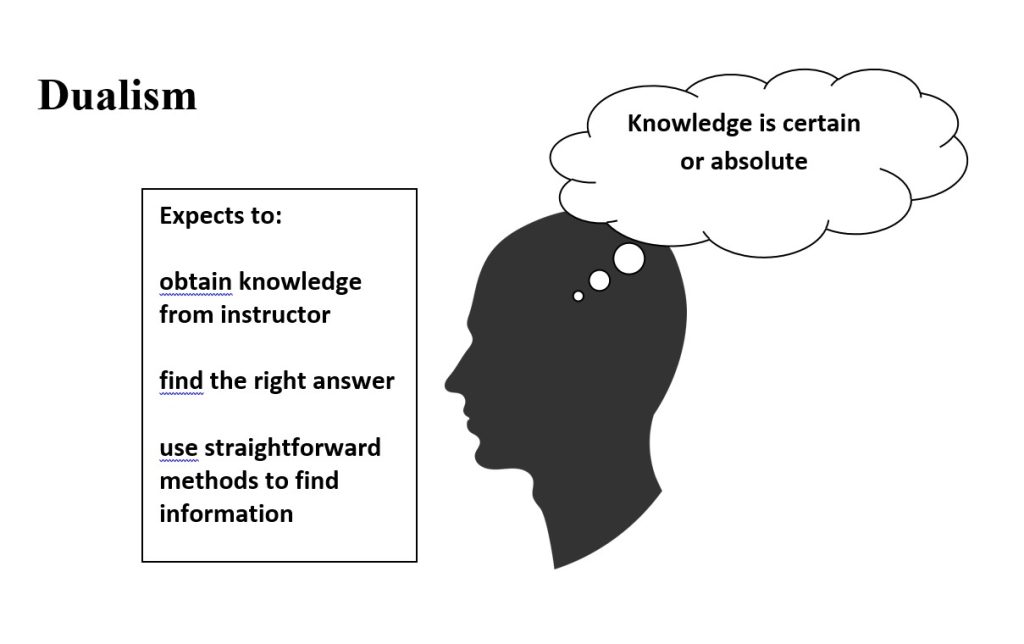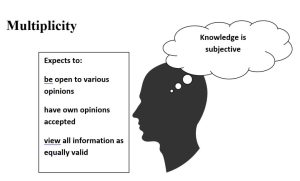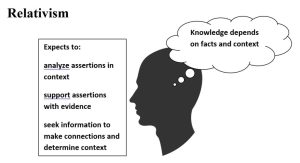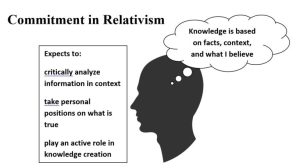20 Scaffolding for Learning: Providing the Right Level of Support
Students’ epistemic beliefs—how they understand knowledge and learning—evolve through distinct stages, influencing how they engage with information. This chapter explores how scaffolding instruction can support students as they progress from dualism (where knowledge is seen as absolute) to multiplicity (where all opinions seem equally valid), then to relativism (where evidence and context shape understanding), and finally to commitment in relativism (where students take an active role in knowledge creation). By aligning teaching strategies with these stages, instructors can provide structured support that fosters critical thinking, synthesis, and independent inquiry. Techniques such as modeling reasoning, structured debates, contextual analysis, and open-ended challenges help students deepen their understanding and take ownership of their learning. Thoughtful scaffolding ensures that students develop the skills needed to critically evaluate knowledge, apply insights across contexts, and become active participants in their education.
Epistemic Beliefs and Scaffolding Instruction
Epistemic beliefs—how students view knowledge and the process of learning—play a crucial role in their cognitive development. As students progress through stages of understanding, from seeing knowledge as absolute to recognizing the complexities of knowledge creation, instructors can scaffold their teaching to meet students where they are, helping them gradually develop more sophisticated ways of thinking.
Instructors can use specific strategies to align their instruction with students’ cognitive development stages. These strategies help students move from basic dualistic thinking, where knowledge is absolute, to the more advanced stages of relativism and commitment, where students critically evaluate knowledge and take ownership of their learning.
Stage 1: Dualism (Knowledge is Absolute)
In this initial stage of epistemic belief, the dualist student believes that gaining knowledge is a process of discovering known truths. Knowledge is handed down from authorities, and learning happens by absorbing existing information. Students at this stage have difficulty understanding the difference between interpretation and opinion, using evidence to support an argument, and appreciating the validity of multiple points of view (King and Kitchener, 1994, p. 251). If a person holds this absolute view of knowledge, they will believe that facts are readily discoverable and will see no point in critically evaluating information (Kuhn and Dean, 2004).

Students in this stage believe that knowledge is absolute and handed down by authorities. They focus on memorization and struggle with interpretation or critical thinking. Effective teaching at this stage requires structure and opportunities to observe and practice reasoning.
Instructional Strategies for Dualism
- Provide Clear Structure with Scaffolding: Use backward design to break down complex tasks into manageable steps that build toward course outcomes. For example, teach argumentation by guiding students through a series of smaller assignments focused on identifying evidence, forming claims, and connecting ideas.
- Model Critical Thinking in Action: Demonstrate problem-solving processes through think-alouds or case-based discussions. By showing how experts navigate uncertainty and make decisions, you help students see that not all problems have a single “correct” answer.
- Ease into Open-Ended Questions: Introduce guided questions such as “Why does this evidence support the claim?” or “How might someone interpret this differently?” These types of questions gently nudge students toward reflection without overwhelming them.
- Start with Concrete Assignments: Focus early tasks on factual recall or direct application to build confidence, and gradually introduce activities that encourage evaluation and interpretation, like comparing different perspectives on a topic.
Stage 2: Multiplicity (All Opinions are Equally Valid)
The shift from dualism to multiplicity has been aptly described as a process of abandoning ignorant certainty for intelligent confusion (Kroll, 1992). In this stage of epistemic belief the student realizes that knowledge is not absolute, and shifts to believing that knowledge is subjective. Students who believe knowledge is subjective tend to assume that all opinions are equally valid. If every opinion is equally valid, critical evaluation is pointless. They have difficulty understanding that opinions should be based on evidence and have trouble distinguishing bias from legitimately different interpretations (King and Kitchener, 1994, p. 252).

At this stage, students recognize that knowledge isn’t always absolute but often assume that all opinions hold equal weight. They need opportunities to practice evaluating the strength of arguments and connecting ideas to evidence.
Instructional Strategies for Multiplicity Stage
- Introduce Evidence-Based Reasoning with Real-World Contexts: Use case studies, primary sources, or practical examples to show the importance of evidence in forming credible arguments. For example, a marketing class might analyze why certain campaigns succeed or fail based on data.
- Encourage Critical Discussion: Structured debates or small-group discussions provide students with a safe space to practice weighing evidence and assessing different viewpoints. Design these activities so students evaluate arguments rather than simply defending positions.
- Compare Perspectives and Evaluate Strengths: Present contrasting viewpoints on an issue and guide students in evaluating the quality of the evidence behind each one. This strategy builds their ability to distinguish between personal opinion and informed judgment.
- Support Complex Assignments with Guidance: Scaffold assignments like research papers by breaking them into smaller tasks, such as finding credible sources, summarizing key arguments, and synthesizing findings into a coherent analysis.
Stage 3: Relativism (Knowledge is Contextual and Evidence-Based)
The stage of relativism is characterized by awareness of the role of facts and evidence in formulating points of view. The student moves beyond thinking that all opinions are equally valid and appreciates the importance of discovering and including information from various perspectives. Students in this stage may still struggle with deciding which points of view are the most valid. But they have come to understand that critical thinking is a valuable tool for making judgments (Kuhn and Dean, 2004). A student at this stage is able to compare perspectives, think through problems, and integrate and apply knowledge (Baxter Magolda, 1992).

Students in this stage understand that knowledge is contextual and evidence-based but may struggle to determine the most valid or applicable perspective. Teaching strategies should focus on helping them synthesize information and draw connections between ideas.
Instructional Strategies for Relativism Stage
- Encourage Synthesis Through Problem-Solving: Assign real-world problems that require students to integrate knowledge from various disciplines or perspectives. For example, in a policy course, students might propose solutions to a local community issue by analyzing data and stakeholder views.
- Foster Collaboration with Structured Roles: Assign group projects where students take on specific responsibilities, such as researching, analyzing, or presenting. Clear roles ensure accountability and help students learn from one another.
- Promote Contextual Analysis in Research Projects: Guide students through projects that involve gathering and critically evaluating sources. Encourage them to apply knowledge to new situations, emphasizing how evidence shapes conclusions.
- Incorporate Reflection into Assignments: Ask students to articulate their reasoning process in written reflections, focusing on how they evaluated evidence and reached conclusions. This metacognitive approach strengthens critical thinking.
In the most advanced stage of epistemic belief, students have learned how to find and evaluate information representing various points of view, and have also recognized their personal role in knowledge formation. It appears rather rare for people to attain this advanced level of understanding. Baxter Magolda (1992) found only two percent of college seniors attained this level, rising to 12% a year after graduation. Perry (1970) identified only 13 out of the 110 seniors in his study as having attained commitment in relativism. Even the doctoral students in King and Kitchener’s (1994) longitudinal study had not all attained this level, but they did exhibit continued growth. Life experience and an open attitude are necessary to internalize commitment in relativism.

In this advanced stage, students take personal responsibility for constructing and contributing to knowledge. They engage in self-directed learning and thrive in open-ended, real-world challenges.
Instructional Strategies for Commitment in Relativism
- Promote Independent Inquiry: Encourage students to design and pursue research projects based on their own interests, guided by clear criteria and feedback checkpoints. This autonomy fosters deeper engagement and ownership of learning.
- Foster Reflective Practices: Incorporate assignments that prompt students to evaluate their progress and learning goals. Journals, self-assessments, or reflective essays can help students develop greater self-awareness and refine their critical thinking.
- Encourage Leadership and Peer Teaching: Engage students as peer mentors or discussion leaders. Teaching others not only reinforces their own learning but also builds leadership skills and fosters community.
- Design Open-Ended Challenges: Assign tasks that allow for multiple valid solutions, such as proposing a sustainable business model or creating a plan to address a community need. These assignments encourage creativity and emphasize the process of knowledge creation.
Scaffolding Instruction to Support Epistemic Development
- Early Stages: For students in the dualist and multiplicity stages, scaffolding should focus on gradually introducing the complexity of knowledge and encouraging students to question their assumptions. Providing clear guidance and concrete examples helps bridge the gap from memorization to critical thinking.
- Middle Stages: In the relativist stage, instructors can introduce more complexity, encouraging students to apply evidence-based reasoning and explore multiple perspectives. Scaffolding in this stage focuses on helping students synthesize information from diverse sources and contexts.
- Advanced Stages: For students at the level of commitment in relativism, scaffolding should allow for greater independence, with a focus on research, reflection, and personal contributions to knowledge creation. Instructors should act as facilitators, guiding students toward self-directed learning and critical engagement.
By aligning instructional strategies with students’ stages of cognitive development, instructors can create learning experiences that challenge students appropriately, encouraging growth in their thinking and understanding.
The framework presented in this chapter is one way to understand students’ evolving epistemic beliefs and how instructional scaffolding can support their development. However, it is not the only model of cognitive growth. Other approaches, such as Wolcott and Lynch’s Steps for Better Thinking model, offer alternative perspectives on how students move from basic knowledge acquisition to critical evaluation and decision-making. While no single model captures the full complexity of learning, these frameworks provide useful tools for designing instruction that meets students where they are and helps them advance toward more sophisticated ways of thinking.
Sources and Attribution
Primary Source
This section is adapted from:
- Educational Psychology for Academic Librarians (n.d.). Theories of College Student Development. https://pressbooks.pub/edpsycforlibrarians/chapter/college-student-development/
Use of AI in Section Development
This section was developed using a combination of existing research and AI-assisted drafting. ChatGPT (OpenAI) was used to:
- Generate instructional strategies based on theories of college student development, ensuring that practical applications align with established research.
- Refine explanations and enhance clarity, making complex developmental theories accessible to instructors.
- Organize concepts effectively, integrating developmental theory with actionable teaching strategies.
While AI-assisted drafting provided a structured foundation, all final content was reviewed, revised, and contextualized to ensure accuracy, pedagogical effectiveness, and alignment with scholarly sources. This section remains grounded in institutional best practices and respects Creative Commons licensing where applicable.
Media Attributions
- dualism-1024×644
- multiplicity-1024×617
- relativism-1024×555
- commitment-768×430
